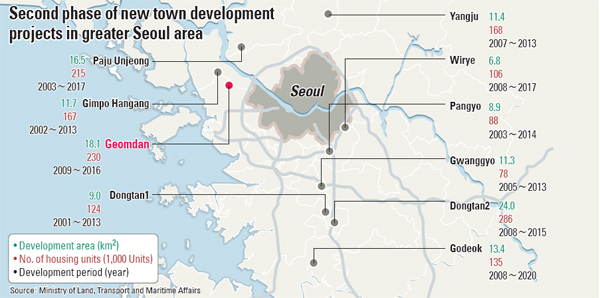Collapse of Incheon new town is end of era

The Ministry of Land, Transport and Maritime Affairs said it has decided to no longer categorize the 694-square-meter (7,470-square-foot) area in Seo District in Incheon as Geomdan new town.
“We have decided to accept the demand of residents in the area to withdraw the designation of the area as a new town,” a Land Ministry official said.
The Geomdan new town project will inevitably be downsized compared to the government’s initial plan.
Previously 18.1 square kilometers was going to be developed. This will shrink to 11.1 square kilometers. Instead of building 92,000 apartments, the new plan will have 70,000. The population will shrink to 177,000 from a planned 230,000.
The government had planned to invest a total of 1.3 trillion won ($1.2 billion) in the project, which was supposed to be completed in the first half of 2016.
The project foundered over compensation disagreements between local property owners and the Incheon Development and Tourism Corporation and the state-run Land & Housing Corporation, which were in charge of development.
With the delays, local property owners asked that the whole plan be scrapped because it restricting their rights to sell their properties or build on them.
Yesterday decision, after 24 years of new town development, shows that the influx of population to the greater Seoul area is slowing and may in fact be reversing with the relocating of government departments to other regions including Sejong City.
Compared to 10 years ago, the number of people moving to the greater Seoul area has been shrinking. While the net number of people that relocated to Seoul and neighboring areas in 2002 amounted to 209,000, last year the net figure was only 8,000.
The year before 7,000 people moved out of the greater Seoul area.
In fact, property values in the new administrative capital of Sejong City surged nearly 22 percent compared to a year earlier. The nation’s average was 2.7 percent, and real estate in the greater Seoul area only inched up 2.18 percent.
Seoul’s frozen real estate market is one of the reasons people don’t want to move there, or to make big gambles on new towns.
Other new town projects such as Paju, Gyeonggi, are also failing to break ground because of conflict over compensation amounts.
The Dongtan 2 new town, one of the most recent new town developments in Hwaseong, Gyeonggi, recently failed to attract potential buyers. The competition for 1,309 housing units for the Daewoo Prugio apartment in the new town fell short of expectations, while Hoban’s apartments didn’t even sell half of its apartments.
Even older apartments, that once saw their values more than double when the market hit its peak in the mid-2000s, are suffering major losses in areas like Bundang.
According to real estate analysts, prices in first-phase new towns have dropped significantly since the 2008 global credit crisis.
In the past five years, Bundang saw its real estate values fall more than 25 percent. Yongin, which is next to Bundang, was down 23 percent followed by Ilsan, another popular new town on the northwestern region near Seoul, which tumbled 22 percent.
“There are no longer any transactions going on,” said a realtor in Bundang. “Many of the realtors are in this neighborhoods are financially wrecked and some are even picking up part time jobs to survive.”
The new town concept appeared in the 1960s. The first modern new town was Ulsan.
But new town development went into full throttle under the Roh Tae-woo administration in the late 1980s and early 1990s.
The new town projects were divided into two phases. In the first phase, five new towns - Bundang, Ilsan, Pyeongchon, Sanbon and Jungdong in Gyeonggi - were constructed. The development of these towns between 1989 and 1996 was designed to accommodate a combined population of nearly 1.2 million people in areas close to Seoul.
The first phase was a success as a huge number of people, especially from the Gangnam area, relocated to Bundang. Along with rising housing prices in the early and mid-2000s, demand in the new towns was hot. Any new apartments attracted huge crowds and competition was fierce.
The second-phase new town projects including Geomdan, Incheon, were hoping to enjoy similar success.
There are 10 new-town projects whose development started in 2001. They are supposed to develop a combined area of 130 square kilometers while building over 613,000 apartment units for more than 1.6 million people.
By Lee Ho-jeong [ojlee82@joongang.co.kr]










with the Korea JoongAng Daily
To write comments, please log in to one of the accounts.
Standards Board Policy (0/250자)